
Cities don't make workers (much) more productive, but productive workers move to cities
Rich countries are industrial, poor countries are agricultural
This simple observation intrigued early scholars, and prompted the conclusion that the key to economic development is the transition of economies out of agriculture and into ‘modern’ sectors. More recently, the question of whether there is ‘too much’ labour in agriculture in poor countries has seen renewed focus. In particular, Restuccia et al. (2008) observe that while agricultural workers have lower measured productivity than non-agricultural workers in all countries, this ‘agricultural productivity gap’ is many times larger in the poorest of countries. As a result, these countries face a double disadvantage where labour is overwhelmingly allocated to a sector that is much less productive, and this raises the possibility that sectoral misallocation is a key factor in explaining cross-country inequality. This belief, in turn, motivates current anti-poverty efforts centred on the use of industrial and social policies that incentivise movement of workers out of rural agricultural and into urban industrial jobs.
Figure 1 Log GDP per capita and agricultural share
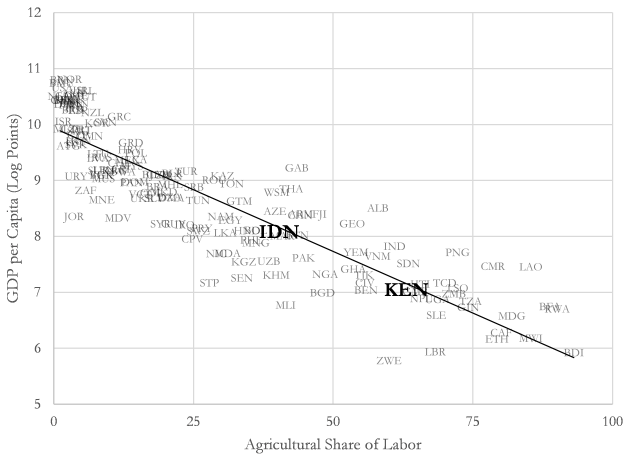
Notes: Table source data is from Gollin et al. (2014), Online Appendix Table 4. Kenya (KEN) and Indonesia (IDN) are highlighted. See Hicks et al. (2018) for further details.
Figure 2 Agricultural share and the agricultural productivity gap
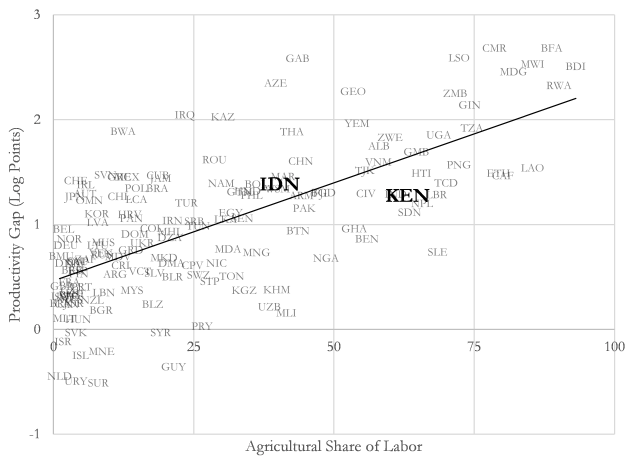
Notes: Table source data is from Gollin et al. (2014), Online Appendix Table 4. Kenya (KEN) and Indonesia (IDN) are highlighted. See Hicks et al. (2018) for further details.
Is it sectors or the workers that are more productive?
A natural questions that follows, and that we aim to address, is whether we should think of these agricultural productivity gaps as ‘causal’ – in the sense that a certain worker is more productive in one sector versus the other – or whether these gaps are the result of different workers sorting into different sectors, an issue prominently brought to light by Young (2013). One of the most important efforts in disentangling causality from selection has been work by Gollin et al. (2014), who show that roughly one-third of the measured differences of agricultural productivity can be accounted for by measurable differences in hours and education, factors that do not necessarily point toward the misallocation hypothesis. Nonetheless, in many countries, this still translates to roughly a doubling of productivity and the “implication is that there should be large income gains from workers moving out of agriculture and into other economic activities” (Gollin et al. 2014: 990).
While important advancements in our understanding of productivity gaps between agricultural and non-agricultural workers – as well as between rural and urban areas – these analyses compare different workers in different sectors in a cross-sectional setting. As such, they may still reflect unobserved differences that have nothing to do with how efficiently developing country labour markets are putting workers in the right jobs. In our study (Hamory Hicks et al. 2018), we aim to improve on this work by using rich longitudinal survey data that track individuals during 28 years in Indonesia and 17 years in Kenya. This allows us to observe the same individual in both sectors and compare their earnings, while correcting for selection into migration, and study how much of the agricultural productivity gaps remains.
Are migrants different from non-migrants?
First, we show that migrants are substantially more skilled than non-migrants in both countries – they have almost double the rate of secondary education attainment as rural non-migrants. Moreover, they also appear to be positively selected on dimensions that are more difficult to capture in a typical dataset. In both contexts, migrants scored roughly 0.2–0.3 standard deviation units higher on tests of cognitive ability. Further, the data show that cognitive test scores strongly predict migration, even when educational attainment is controlled for. This already hints that there are parts of human capital that are usually hard to measure but that are important for sorting across sectors. Our identification strategy using individual fixed effects is able to account for this type of sorting.
How large are sectoral productivity gaps once we control for selection into migration?
Using our detailed and high quality data, we are able to replicate large cross-sectional productivity differences between sectors, as seen in previous work. As our main result, however, when we compare the experiences of the same individual when they work in different sectors, the productivity differences drop by 80% to 100%. This is true for productivity differences between agriculture and non-agricultural sectors, as well as between rural and urban areas. Furthermore, we observe this pattern not just for productivity differences, but also for differences in consumption, which more closely resembles welfare and which allows us to include individuals without paid employment into our analysis.
Figure 3 Productivity gap in total earnings
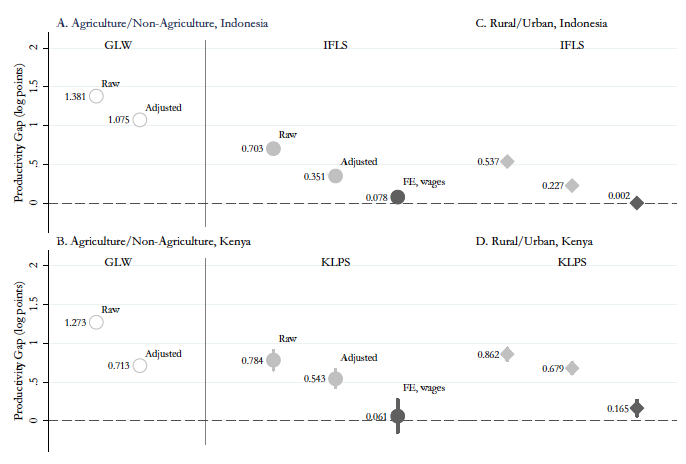
Notes: IFLS: Indonesia Family Life Survey; KLPS: Kenya Life Panel Survey;GLW refers to estimates from Gollin et al. (2014), Online Appendix Table 4 using data from national accounts. See Hicks et al. (2018) for further details.
Time and space
In the absence of substantial average sectoral productivity differences, we test two possibilities in the spirit of De La Roca and Puga (2017)’s recent study.
First, we test to see whether urban migration has varied effects by looking separately at migration to the largest five cities in each country, continuing to compare the same individual over time. In Indonesia, we do not observe much evidence that there is a positive effect of the largest cities, but in Kenya, productivity differences are higher in Nairobi and Mombasa, though still substantially smaller than productivity differences one observes comparing across individuals.
Figure 4 Event study of urban migration
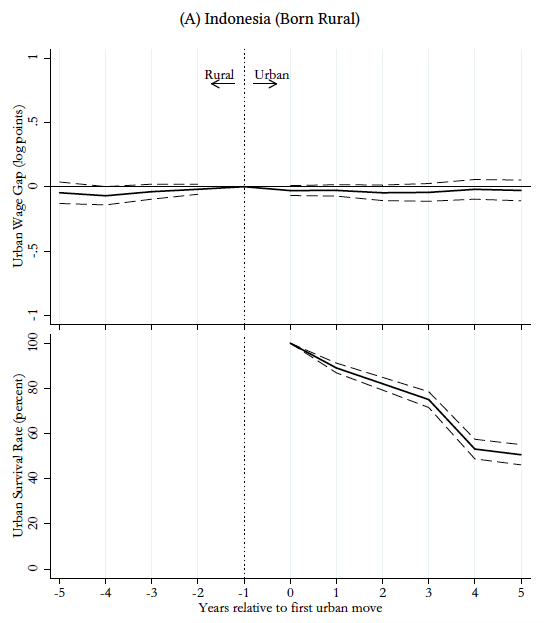
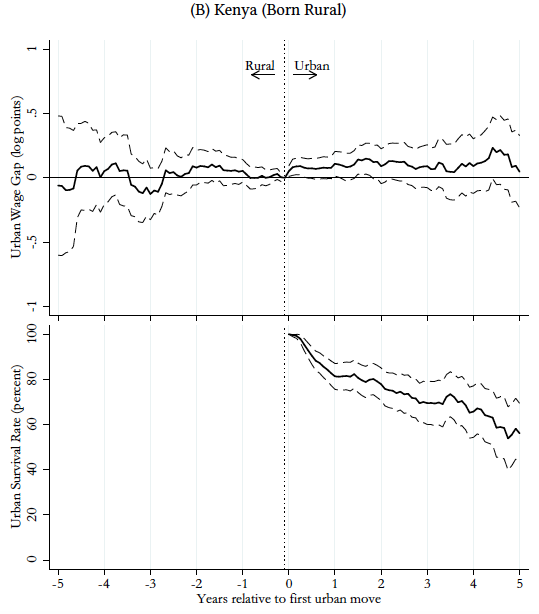
Notes: Panel A uses data from individuals in the IFLS who are born in rural areas, and Panel B uses data from the KLPS. See Hicks et al. (2018) for further details.
Second, we test to see whether migration’s effects may take some time to materialise. Tracking rural-to-urban migrants over five years from when they first move, we see no evidence of experience effects. Could it be that the effects of migration take longer than five years to materialise? Recent work by Nakamura et al. (2017) finds that migration improves employment outcomes for the next generation. While our study is not able to say whether there are intergenerational productivity effects of migration, we do observe that the children of migrants have higher cognitive ability, even after controlling for parents’ cognitive ability, which suggests that urban areas may have positive effects on cognitive development, for example due to better schools, or more social interactions.
The experiences of migrants and reallocative policy
Our research suggests that correcting sectoral ‘misallocation’ and encouraging workers to leave agriculture and rural areas is not likely to be a silver bullet anti-poverty measure. Much of the observed sectoral productivity differences are driven by differences between individuals rather than differences in sector.
Naturally, one could ask whether using migrants as case studies is necessarily generalisable to non-migrants. The case for reallocation rests on the potential that non-migrants are both more productive than migrants and more constrained in their ability to move. While the positive selection of individuals on observable characteristics pushes against this hypothesis—one might naturally assume that more educated individuals are both absolutely more productive in both rural and urban settings and relatively more productive in urban settings—this is a very real possibility, and we encourage research in this direction. For instance, recent work uses experimental methods to induce migration, and finds moderate positive returns to short-term migration in Bangladesh (Bryan et al 2014).
A separate but related issue is whether families would be better off with such policies. Even if migration to urban areas conferred higher wages and consumption – neither of which we observe – such an endeavour is risky – workers are subject to more unemployment and often work in low-skill service sectors. Workers may also be subject to higher crime and separation from families may take a psychological toll. One cautionary tale is the forced migration experience of Operation Vijiji in Tanzania in 1973, where the authoritarian government resorted to forced migration to move rural populations into larger villages and towns in order to speed up economic modernisation. The resulting economic and social dislocation is today widely viewed as a policy disaster and was abandoned within a year in the face of large-scale resistance (Stren et al. 1994).
References
De La Roca, J and D Puga (2017), “Learning by working in big cities,” Review of Economic Studies 84 (1): 106–142.
Gollin, D, D Lagakos and M Waugh (2014), “The agricultural productivity gap,” Quarterly Journal of Economics 129 (2): 939–993.
Hamory Hicks, J, M Kleemans, N Li, E Miguel (2018), “Reevaluating agricultural productivity Gaps with longitudinal microdata,” NBER Working Paper.
Nakamura, E, J Sigurdsson and J Steinsson (2017), “The gift of moving: Intergenerational consequences of a mobility Shock,” Working Paper.
Restuccia, D, D Yang and X Zhu (2008), “Agriculture and aggregate productivity: A quantitative cross-country analysis,” Journal of Monetary Economics 55 (2): 234–250.
Stren, R, M Halfani and J Malombe (1994), “Coping with urbanisation and urban policy” in Beyond capitalism vs. socialism in Kenya and Tanzania, Colorado: Lynne Rienner.
Young, A (2013), “Inequality, the urban-rural gap, and migration,” Quarterly Journal of Economics 128 (4): 1727–1785.




